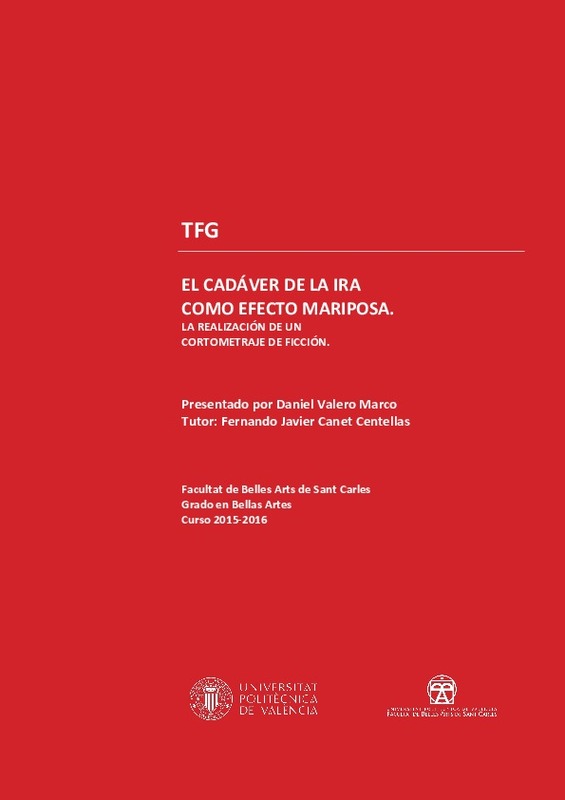JavaScript is disabled for your browser. Some features of this site may not work without it.
Buscar en RiuNet
Listar
Mi cuenta
Estadísticas
Ayuda RiuNet
Admin. UPV
EL CADÁVER DE LA IRA COMO EFECTO MARIPOSA: LA REALIZACIÓN DE UN RELATO DE FICCIÓN
Mostrar el registro sencillo del ítem
Ficheros en el ítem
| dc.contributor.advisor | Canet Centellas, Fernando Javier
|
es_ES |
| dc.contributor.author | Valero Marco, Daniel
|
es_ES |
| dc.date.accessioned | 2016-12-12T16:17:09Z | |
| dc.date.available | 2016-12-12T16:17:09Z | |
| dc.date.created | 2016-09-26 | |
| dc.date.issued | 2016-12-12 | es_ES |
| dc.identifier.uri | http://hdl.handle.net/10251/75124 | |
| dc.description.abstract | [ES] El presente proyecto trata sobre la realización de un cortometraje de ficción con el tema de la ira y el efecto mariposa. En primer lugar se realiza un proceso de documentación teórica en el que se estudia el comportamiento de la ira y se relaciona con el efecto mariposa de la teoría del caos. Tras esto, se plantea la creación de un cortometraje de ficción que refleje las principales conclusiones de la investigación realizada. Para la buena ejecución del cortometraje se plantea una búsqueda de referentes cinematográficos con los que se estudia como trasmitir dichas conclusiones mediante la narración audiovisual que concluye con la película Magnolia (Paul Thomas Anderson, 1999), la cual se analiza en profu ndidad. Por último se procede a exponer una memoria completa de la realización del cortometraje en la que se explican las diferentes fases del proyecto; como son: preproducción, producción y postproducción, poniendo especial énfasis en el proceso de creación del guion y como las diferentes fases del proyecto lo van haciendo evolucionar. | es_ES |
| dc.description.abstract | [EN] This Project deals with the production of a short fictio n film which is themed with the anger and the butterfly effect. In the first place a theory documentation process is done, in which the behavior of anger is studied and related to the butterfly effect of chaos theory. After this, the production of a short fiction film that reflects the main findings of the research is considered. For the proper performance of the short film, a search for cinematographic examples is carried out, with which it is studied how to transmit these conclusions by means of audiovisual narrative. This search concludes with the film Magnolia (Paul Thomas Anderson, 1999), which is analyzed in depth. Lastly, a full report of the short film production is presented, in which the different stages of this project are expla ined; that is to say pre - production, production and post - production, with special emphasis on the process of creating the script and how the different phases of this project are doing it evolve | es_ES |
| dc.format.extent | 30 | es_ES |
| dc.language | Español | es_ES |
| dc.publisher | Universitat Politècnica de València | es_ES |
| dc.rights | Reserva de todos los derechos | es_ES |
| dc.subject | ira | es_ES |
| dc.subject | efecto mariposa | es_ES |
| dc.subject | ficción | es_ES |
| dc.subject | audiovisual | es_ES |
| dc.subject | Realización | es_ES |
| dc.subject.classification | COMUNICACION AUDIOVISUAL Y PUBLICIDAD | es_ES |
| dc.subject.classification | BIBLIOTECONOMIA Y DOCUMENTACION | es_ES |
| dc.subject.other | Grado en Bellas Artes-Grau en Belles Arts | es_ES |
| dc.title | EL CADÁVER DE LA IRA COMO EFECTO MARIPOSA: LA REALIZACIÓN DE UN RELATO DE FICCIÓN | es_ES |
| dc.type | Proyecto/Trabajo fin de carrera/grado | es_ES |
| dc.rights.accessRights | Abierto | es_ES |
| dc.contributor.affiliation | Universitat Politècnica de València. Facultad de Bellas Artes - Facultat de Belles Arts | es_ES |
| dc.contributor.affiliation | Universitat Politècnica de València. Departamento de Comunicación Audiovisual, Documentación e Historia del Arte - Departament de Comunicació Audiovisual, Documentació i Història de l'Art | es_ES |
| dc.description.bibliographicCitation | Valero Marco, D. (2016). EL CADÁVER DE LA IRA COMO EFECTO MARIPOSA: LA REALIZACIÓN DE UN RELATO DE FICCIÓN. http://hdl.handle.net/10251/75124. | es_ES |
| dc.description.accrualMethod | TFGM | es_ES |
| dc.relation.pasarela | TFGM\43815 | es_ES |
Este ítem aparece en la(s) siguiente(s) colección(ones)
-
BBAA - Trabajos académicos [4517]
Facultad de Bellas Artes






